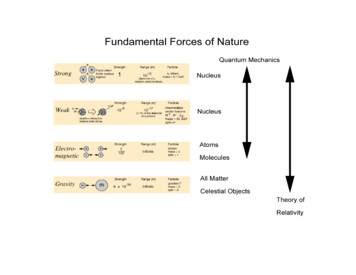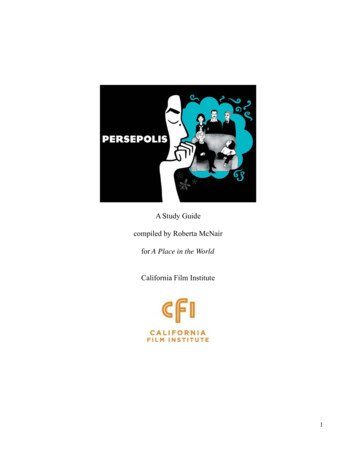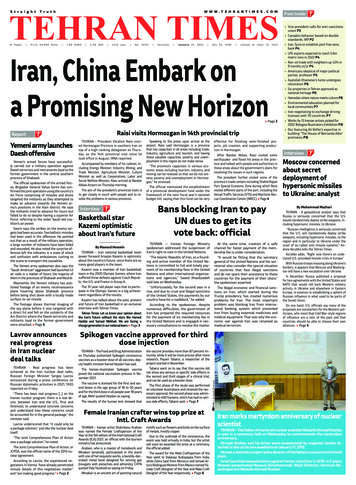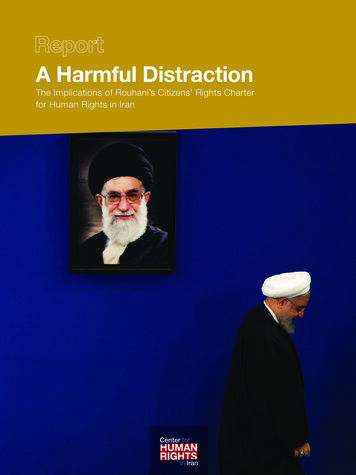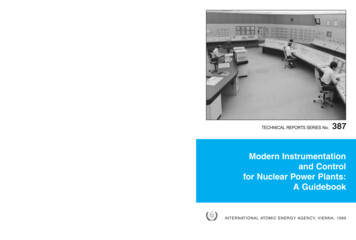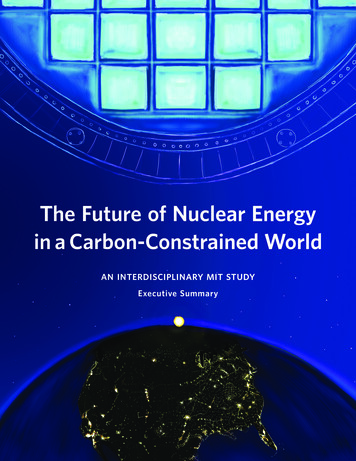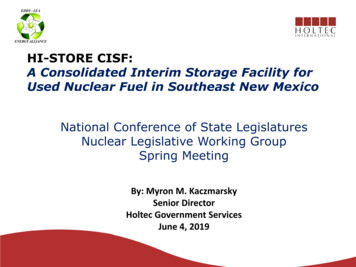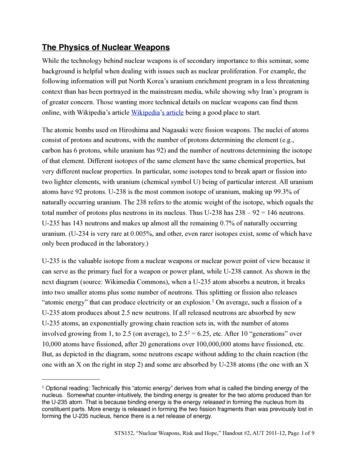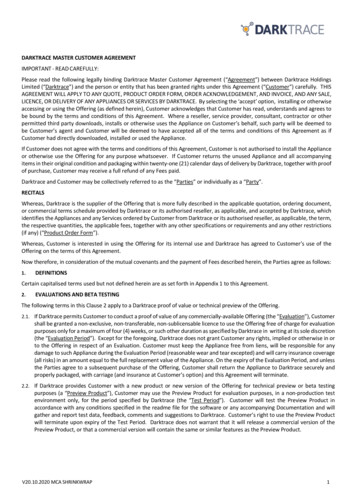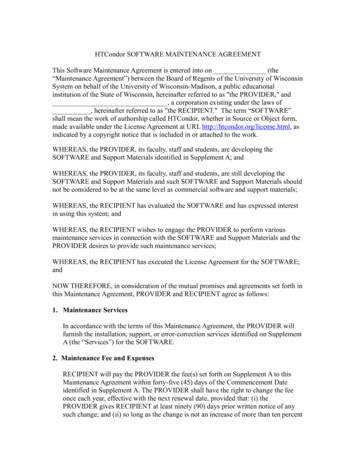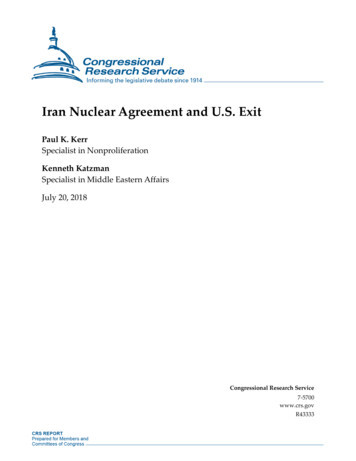
Transcription
Iran Nuclear Agreement and U.S. ExitPaul K. KerrSpecialist in NonproliferationKenneth KatzmanSpecialist in Middle Eastern AffairsJuly 20, 2018Congressional Research Service7-5700www.crs.govR43333
Iran Nuclear AgreementSummaryOn July 14, 2015, Iran and the six powers that had negotiated with Tehran about its nuclearprogram since 2006 (the United States, the United Kingdom, France, Russia, China, andGermany—collectively known as the P5 1) finalized a Joint Comprehensive Plan of Action(JCPOA). The JCPOA required constraints that seek to ensure that Iran’s nuclear program can beused for purely peaceful purposes in exchange for a broad lifting of U.S., European Union (EU),and United Nations (U.N.) sanctions on Iran. The agreement replaced the Joint Plan of Action(JPA), an interim nuclear accord in effect from 2014 to 2016. Congress did not enact a resolutionof disapproval of the JCPOA by the deadline of September 17, 2015, which was set by the IranNuclear Agreement Review Act (P.L. 114-17); the JCPOA formally took effect on “AdoptionDay” (October 18, 2015). “Implementation Day” was declared by the P5 1 on January 16, 2016,representing the completion of Iran’s nuclear requirements; entry into effect of U.N. SecurityCouncil Resolution 2231, which endorsed the JCPOA; and the start of sanctions relief stipulatedin the agreement. Officials from both the Barack Obama and Donald Trump Administrations havecertified that Iran has abided by its JCPOA commitments.The Obama Administration and other P5 1 leaders asserted that the JCPOA is the most effectivemeans to ensure that Iran cannot obtain a nuclear weapon and that all U.S. options to prevent Iranfrom developing a nuclear weapon are available indefinitely. The agreement contains provisionsfor U.N. sanctions to be reimposed if Iran violates its commitments.Top Trump Administration officials have argued that the JCPOA does not adequately serve U.S.interests because the extensive sanctions relief provided under the accord gives Iran additionalresources to conduct “malign activities” in the region, and does not restrict Iran’s development ofballistic missiles. Resolution 2231, which was adopted in July 2015, prohibits arms transfers to orfrom Iran, but only for five years, and contains a voluntary restriction on Iran’s development ofnuclear-capable ballistic missiles for only up to eight years.On May 8, President Trump announced that the United States would no longer participate in theJCPOA and would reimpose sanctions that had been suspended pursuant to the agreement. Theother powers that negotiated the accord with Iran—Russia, China, France, Britain, andGermany—opposed the U.S. decision and have been meeting with Iranian officials to continueimplementing the JCPOA. Iran’s President Hassan Rouhani has pledged to continueimplementing the accord, provided Iran continues to receive the economic benefits of theagreement.In the 114th and 115th Congresses, legislation has been introduced with the stated purpose ofredressing asserted weaknesses of the deal or preventing any U.S. sanctions relief beyond thatexplicitly promised in the JCPOA. The Countering America’s Adversaries through Sanctions Act(P.L. 115-44) mandates sanctions on Iranian proliferation, human rights abuses, and support forterrorist activities. For details on the sanctions relief aspects of the JCPOA, see CRS ReportRS20871, Iran Sanctions, by Kenneth Katzman.Congressional Research Service
Iran Nuclear Agreement and U.S. ExitContentsIntroduction . 1Background on Iran’s Nuclear Program . 2IAEA Safeguards. 3Declared Iranian Nuclear Facilities . 4The “Joint Plan of Action” (JPA) . 5Nuclear Program Provisions under the JPA . 5“Right to Enrichment” . 7Sanctions Easing Under the JPA . 7The Joint Comprehensive Plan of Action (JCPOA) . 7Timeline for Implementing the JCPOA . 8Major Nuclear Provisions of the JCPOA . 9Enrichment Program . 9Arak Reactor . 11Other Provisions . 12Iranian Compliance with the JCPOA Nuclear Requirements . 19Sanctions Relief under the JCPOA and Reimposition . 20Formal Congressional Review and Oversight . 21Ongoing Oversight under INARA . 21U.S. Implementation of and Exit from the JCPOA . 22The JCPOA in the Trump Administration . 22U.S. Exit from the JCPOA . 24Reaction to the U.S. Exit. 25Efforts to Preserve the Accord . 27TablesTable A-1. Summary of Timeline . 29Table A-2. JCPOA Commitments. 30AppendixesAppendix A. Chart on the JCPOA . 29Appendix B. Nuclear Weapons Development . 34ContactsAuthor Contact Information . 35Congressional Research Service
Iran Nuclear Agreement and U.S. ExitIntroductionMultilateral negotiations regarding Iran’s nuclear program date back to 2003 after theInternational Atomic Energy Agency (IAEA) reported on the existence of clandestine nuclearfacilities at Natanz. In October of that year, Iran concluded an agreement with France, Germany,and the United Kingdom under which Iran temporarily suspended aspects of its nuclear program,including enrichment of uranium, and signed an Additional Protocol to its IAEA safeguardsagreement, but also asserted its right to develop nuclear technology. In January 2006, Tehranannounced that it would resume research and development on its centrifuges at Natanz. After thattime, Iran held multiple rounds of talks with China, France, Germany, Russia, the UnitedKingdom, and the United States (collectively known as the P5 1).The U.N. Security Council meanwhile adopted several resolutions, the most recent and sweepingof which (Resolution 1929) was adopted in June 2010. These resolutions required Iran tocooperate fully with an ongoing IAEA investigation of its nuclear activities, suspend its uraniumenrichment program, suspend its construction of a heavy water reactor and related projects, andratify the Additional Protocol to its IAEA safeguards agreement. Resolution 1929 also requiredTehran to refrain from “any activity related to ballistic missiles capable of delivering nuclearweapons” and to comply with a modified provision (called code 3.1) of Iran’s subsidiaryarrangement to its IAEA safeguards agreement.1 The resolutions also imposed sanctions on Iran.Diplomacy bore fruit after the June 2013 election of Iranian President Hassan Rouhani with theachievement, on November 24, 2013, of an interim nuclear accord—the Joint Plan of Action(JPA; referred to in international documents as JPOA). The JPA set out an approach towardreaching a long-term comprehensive solution to international concerns regarding Iran’s nuclearprogram. The two sides began implementing the JPA on January 20, 2014. The P5 1 and Iranreached a framework of a Joint Comprehensive Plan of Action (JCPOA) on April 2, 2015, and theJCPOA was finalized on July 14, 2015. With the JPA remaining in effect until the JCPOA enteredinto implementation, the IAEA certified on January 16, 2016, that Iran had completed its requiredJCPOA nuclear-related tasks for Implementation Day. The United States, the U.N., and the EUceased application of most sanctions that day. Since Implementation Day, the agency has“verified and monitored Iran’s implementation of its [JCPOA] nuclear-related commitments.”2On November 11, 2013, coinciding with concluding the JPA, Iran and the IAEA signed a jointstatement that included a “Framework for Cooperation”3 to “strengthen their cooperation anddialogue aimed at ensuring the exclusively peaceful nature of Iran’s nuclear programme throughthe resolution of all outstanding issues that have not already been resolved by the IAEA.” Theagency had long sought to resolve some outstanding questions regarding Tehran’s nuclearprogram, some of which concern possible Iranian research on nuclear weapons development.1Iran is a party to the nuclear Non Proliferation Treaty (NPT) and has concluded a comprehensive safeguardsagreement with the IAEA. Such agreements are designed to enable the IAEA to detect the diversion of nuclear materialfrom peaceful purposes to nuclear weapons uses, as well as to detect undeclared nuclear activities and material. Formore information, see CRS Report R40094, Iran’s Nuclear Program: Tehran’s Compliance with InternationalObligations, by Paul K. Kerr.2 Verification and Monitoring in the Islamic Republic of Iran in Light of United Nations Security Council Resolution2231 (2015), Report by the Director General, International Atomic Energy Agency, GOV/2018/24, May 24, 2018.3 Available at http://www.iaea.org/press/?p 4018.Congressional Research Service1
Iran Nuclear Agreement and U.S. ExitAmano issued the IAEA’s “Final Assessment on Past and Present Outstanding Issues RegardingIran’s Nuclear Programme” on December 2, 2015.4Background on Iran’s Nuclear Program5Iran has nuclear programs that could potentially provide Tehran with the capability to produceboth weapons-grade highly enriched uranium (HEU) and plutonium—the two types of fissilematerial used in nuclear weapons. (In addition to the production of weapons-grade nuclearmaterial, a nuclear weapons program requires other key elements, such as warhead design andreliable delivery systems [see Appendix B].) Statements from the U.S. intelligence communityindicate that Iran has the technological and industrial capacity to produce nuclear weapons atsome point, but the U.S. government assesses that Tehran has not mastered all of the necessarytechnologies for building a nuclear weapon.6A November 2007 National Intelligence Estimate7 assessed that Iran “halted its nuclear weaponsprogram” in 2003,8 but the estimate and subsequent statements by the intelligence communityalso assessed that Tehran was keeping open the “option” to develop nuclear weapons.9 ThenUnder Secretary of State for Political Affairs Wendy Sherman explained during an October 3,2013, Senate Foreign Relations Committee hearing that Iran would need as much as one year toproduce a nuclear weapon if the government made the decision to do so.10 Tehran would haveneeded two to three months of this time to produce enough weapons-grade HEU for a nuclearweapon.11 Iran’s implementation of the JCPOA lengthened the latter timeline to one year,according to February 9, 2016, congressional testimony from then-Director of NationalIntelligence James Clapper.12 (See “Major Nuclear Provisions of the JCPOA.”)Final Assessment on Past and Present Outstanding Issues Regarding Iran’s Nuclear Programme, GOV/2015/68,December 2, 2015.5For more information, see CRS Report RL34544, Iran’s Nuclear Program: Status, by Paul K. Kerr.6 “Press Briefing by Senior Administration Officials on IAEA Report on Iran’s Nuclear Activities,” November 8, 2011.Ambassador Stephen D. Mull, Coordinator for Implementation of the JCPOA, told a Washington audience on January21, 2016, that “there was a portion of the Iranian Government working in a very organized, systematic way to developthe capability to build a nuclear weapon. We don’t know to the extent to which that knowledge has been tested or evensurvived.” (“Implementation of the Joint Comprehensive Plan of Action,” Washington Foreign Press Center, January21, 2016.)7 “Iran: Nuclear Intentions and Capabilities,” National Intelligence Estimate, November 2007.8 The estimate defined “nuclear weapons program” as “nuclear weapon design and weaponization work and coverturanium conversion-related and uranium enrichment related work.”9 See, for example, Director of National Intelligence James Clapper’s February 26, 2015, testimony before the SenateArmed Services Committee (Statement for the Record, Worldwide Threat Assessment of the U.S. IntelligenceCommunity, February 26, 2015).10 This estimate assumes the necessary time to produce a sufficient amount of weapons-grade HEU and complete theremaining steps necessary for an implosion-style nuclear explosive device suitable for explosive testing. (Conversationwith U.S. official, July 21, 2015.) “Reversing Iran’s Nuclear Program,” Senate Foreign Relations Committee, October3, 2013.11 The White House. “Parameters for a Joint Comprehensive Plan of Action Regarding the Islamic Republic of Iran’sNuclear Program.” April 2, 2015.12 Statement for the Record Worldwide Threat Assessment of the US Intelligence Community, Senate Armed ServicesCommittee, February 9, 2016. Director of National Intelligence Daniel Coats reiterated this assessment in May 2017(Statement for the Record Worldwide Threat Assessment of the Intelligence Community, Senate Select Committee onIntelligence, May 11, 2017) and February 2018 (Statement for the Record Worldwide Threat Assessment of theIntelligence Community, February 13, 2018). Then-UK Secretary of State for Foreign and Commonwealth AffairsBoris Johnson also reiterated this assessment in a May 9, 2018, statement to Parliament (“Iran Nuclear Deal,” Hansard4Congressional Research Service2
Iran Nuclear Agreement and U.S. ExitU.S. officials argue that the IAEA and/or U.S. intelligence would likely detect an Iranian attemptto produce weapons-grade HEU with either its safeguarded facilities or clandestine facilities.13Regarding the former, Clapper testified that the JCPOA hasenhanced the transparency of Iran’s nuclear activities . [a]s a result, the internationalcommunity is well postured to quickly detect changes to Iran’s declared nuclear facilitiesdesigned to shorten the time Iran would need to produce fissile material. 14The intelligence community assesses that Iran is more likely to use clandestine facilities toproduce weapons-grade HEU, Director Clapper stated in a March 2015 interview.15 U.S. officialshave expressed confidence in the ability of U.S. intelligence to detect Iranian covert nuclearfacilities16 and have indicated that Iran currently does not appear to have any nuclear facilities ofwhich the United States is unaware.IAEA SafeguardsThe IAEA’s ability to inspect and monitor nuclear facilities in, as well as to obtain informationfrom, a particular country pursuant to that government’s comprehensive safeguards agreementhas been limited to facilities and activities that have been declared by the government. AdditionalProtocols to IAEA comprehensive safeguards agreements increase the agency’s ability toinvestigate undeclared nuclear facilities and activities by increasing the IAEA’s authority toinspect certain nuclear-related facilities and demand information from member states. Iran signedsuch a protocol in December 2003 and agreed to implement the agreement pending ratification.However, following the 2005 breakdown of limited agreements with the European countries tosuspend uranium enrichment, Tehran stopped adhering to its Additional Protocol in 2006.17Subsidiary arrangements to IAEA safeguards agreements describe the “technical andadministrative procedures for specifying how the provisions laid down in a safeguards agreementare to be applied.”18 Code 3.1 of Iran’s subsidiary arrangement to its IAEA safeguards agreementrequires Tehran to provide design information for new nuclear facilities “as soon as the decisionto construct, or to authorize construction, of such a facility has been taken, whichever is earlier.”Online, May 9, 2018, Volume 640. Available at: learDeal 1/17 ).13 “Hearing on Security Threats to the United States,” Senate Select Committee on Intelligence, March 12, 2013. ThenIAEA Deputy Director General for Safeguards Herman Nackaerts stated in July 2013 that the IAEA “would knowwithin a week” if Iran were to use its safeguarded facilities to produce weapons-grade HEU. (Barbara Slavin, “TightIAEA Inspection Regime Hampers Iran’s Nuclear Breakout,” Al-Monitor, July 22, 2013.)14 Statement for the Record Worldwide Threat Assessment of the US Intelligence Community, February 9, 2016.15 PBS “Charlie Rose” Interview with James Clapper, Director of National Security, March 3, 2015.16 “Senior Administration Official Holds A Background Briefing Previewing Iran P5 1 Talks,” November 6, 2013;Colin H. Kahl, “Not Time to Attack Iran: Why War Should Be a Last Resort,” Foreign Affairs, January 17, 2012.However, Director of National Intelligence Clapper stated in a February 2015 hearing that, although the United Stateshas “a reasonably capable intelligence capability,” IAEA safeguards would be an “important aspect of any sort ofagreement we might reach with the Iranians” (Worldwide Threat Assessment of the U.S. Intelligence Community,February 26, 2015).17 Iran announced that it would stop implementing the protocol two days after the IAEA Board of governors adopted aresolution in February 2006 which referred Iran’s noncompliance with its IAEA safeguards agreement to the U.N.Security Council.18 2001 IAEA Safeguards Glossary. Available at SafeguardsGlossary-2001-Edition.Congressional Research Service3
Iran Nuclear Agreement and U.S. ExitDeclared Iranian Nuclear Facilities19Iran did not build any new nuclear facilities or expand the existing facilities since the JPA wentinto effect in January 2014. Iran operates a Russian-built nuclear power reactor, for which Russiais providing fuel until 2021. The JCPOA focuses on Iran’s enrichment program and its heavywater reactor due to their potential for nuclear weapons material production.Iran has two gas centrifuge enrichment facilities: the Natanz Fuel Enrichment Plant and theNatanz Pilot Fuel Enrichment Plant. Gas centrifuges enrich uranium by spinning uraniumhexafluoride gas at high speeds to increase the concentration of the uranium-235 isotope. Suchcentrifuges can produce low-enriched uranium (LEU), which can be used for fuel in nuclearpower reactors or research reactors, and weapons-grade highly enriched uranium (HEU). LEUused in nuclear power reactors typically contains less than 5% uranium-235; research reactor fuelcan be made using 20% uranium-235; HEU used in nuclear weapons typically contains about90% uranium-235. Tehran argues that it is enriching uranium for use as fuel in nuclear powerreactors and nuclear research reactors. Natanz Commercial-Scale Fuel Enrichment Plant. In this facility, Iran is usingfirst-generation centrifuges, called IR-1 centrifuges, to produce LEU containingup to 5% uranium-235. As of November 2013, Iran had installed about 15,400 ofthese centrifuges, approximately 8,800 of which are enriching uranium. Iran hadalso installed about 1,000 centrifuges with a greater enrichment efficiency, calledIR-2m centrifuges, in the facility, but they are not enriching uranium.Natanz Pilot Fuel Enrichment Plant. Iran had been using IR-1 centrifuges inthis facility to produce LEU containing approximately 20% uranium-235 untilhalting this work pursuant to the JPA. Tehran’s production of LEU enriched tothe 20% level has caused concern because such production requiresapproximately 90% of the effort necessary to produce weapons-grade HEU,which, as noted, contains approximately 90% uranium-235.20 Iran is testing othercentrifuge models in this facility under IAEA supervision, but such work wasmonitored by the IAEA, even before the JPA (see below) limited this testing.Iran has been constructing a nuclear reactor moderated by heavy water at Arak,21 a type of reactorthat produces spent fuel containing plutonium that is better suited for nuclear weapons thanplutonium produced by light water-moderated reactors.22 Tehran has asserted that the reactor isintended to produce radioisotopes for medical use and to replace the Tehran Research Reactor.Heavy water production requires a separate production plant, which Iran possesses. Prior toJCPOA implementation, the Arak reactor, if it had been completed, could have produced enoughUnless otherwise noted, this section is based on CRS Report RL34544, Iran’s Nuclear Program: Status, by Paul K.Kerr, and reports from IAEA Director-General Yukiya Amano to the IAEA Board of Governors: GOV/2013/27 (May2013), GOV/2013/40 (August 2013), GOV/2013/56 (November 2013, and GOV/2015/34 (May 2015).20 Former IAEA Deputy Director General Olli Heinonen, “Dealing with a Nuclear Iran: Redlines and Deadlines,”Center for Strategic and International Studies, February 6, 2013; U.S. Secretary of Energy Ernest Moniz, SenateCommittee on Armed Services, “Impacts of the Joint Comprehensive Plan of Action (JPCOA) on U.S. Interests and theMilitary Balance in the Middle East,” July 29, 2015.21 Iran informed the IAEA in April 2017 that Tehran was renaming the facility, which Iran had called the “Arak HeavyWater Research Reactor,” the “Khondab Heavy Water Research Reactor.” Verification and Monitoring in the IslamicRepublic of Iran in Light of United Nations Security Council Resolution 2231 (2015), Report by the Director General,International Atomic Energy Agency, GOV/2017/24, June 2, 2017.22 Both the Tehran Research Reactor and the Bushehr reactor are light-water reactors.19Congressional Research Service4
Iran Nuclear Agreement and U.S. Exitplutonium for between one and two nuclear weapons per year.23 However, plutonium must beseparated from the used fuel—a procedure called “reprocessing.” Iran has always maintained thatit would not engage in reprocessing. Prior to the JPA, Tehran notified the IAEA that it hadproduced enough heavy water to commission the reactor.The “Joint Plan of Action” (JPA)The JPA, also widely known as the JPOA, essentially froze most aspects of Iran’s nuclearprogram to allow time to negotiate the JCPOA. When the JPA went into effect in January 2014,Iran had enough uranium hexafluoride containing up to 5% uranium-235, which, if furtherenriched, would have yielded enough weapons-grade HEU for as many as eight nuclearweapons.24 The total amount of Iranian LEU containing 20% uranium-235 would, if it had beenfurther enriched, have been sufficient for a nuclear weapon. After the JPA went into effect, Iraneither converted much of that material for use as fuel in a research reactor located in Tehran(called the Tehran Research Reactor), or prepared it for that purpose.25 Iran diluted the rest of thatstockpile so that it contained no more than 5% uranium-235. Tehran’s uranium conversion facilityis not set up to reconvert the reactor fuel to uranium hexafluoride.26 According to a November 14,2013, IAEA report, Iran had generally stopped expanding its enrichment and heavy water reactorprograms during the negotiations leading up to the JPA.27Nuclear Program Provisions under the JPA28Under the JPA, Iran agreed to refrain from “any further advances of its activities” at the Natanzcommercial-scale facility, Fordow facility, and Arak reactor. Tehran was also required to providethe IAEA with additional information about its nuclear program, as well as access to somenuclear-related facilities to which Iran’s IAEA safeguards agreement does not require access. TheJPA required Iran: Centrifuge Limits. To refrain from feeding uranium hexafluoride into itsinstalled centrifuges that were not previously enriching uranium, to replaceexisting centrifuges only with “centrifuges of the same type,” and to producecentrifuges only to replace damaged centrifuges. Tehran was also required torefrain from installing additional centrifuges at the Natanz facility. Iran waspermitted to use its previously operating centrifuges in the Natanz commercial23Kahl, May 14, 2015.Colin Kahl, Deputy Assistant to the President and National Security Adviser to the Vice President, “Arms ControlAssociation Annual Meeting: Unprecedented Challenges for Nonproliferation and Disarmament,” May 14, 2015.25 This process has generated scrap which contains LEU with 20% uranium-235. Iran also retains .6 kilograms ofuranium hexafluoride containing 20% uranium-235, which “had been used as reference material for massspectrometry” (Implementation of the NPT Safeguards Agreement and relevant provisions of Security Councilresolutions in the Islamic Republic of Iran, Report of the Director General, International Atomic Energy Agency,GOV/2015/34, May 29, 2015).26 Nuclear Industry in Iran: An Overview on Iran’s Activities and Achievements in Nuclear Technology, Atomic EnergyOrganization of Iran, 2012, p. 13. Also see GOV/2015/34.27 Implementation of the NPT Safeguards Agreement and Relevant Provisions of Security Council Resolutions in theIslamic Republic of Iran, GOV/2013/56, November 14, 2013.28 Unless otherwise noted, this section is based on the agreement text (available at http://eeas.europa.eu/statements/docs/2013/131124 03 en.pdf), “Background Briefing by Senior Administration Officials on First Step Agreement onIran’s Nuclear Program,” November 24, 2013, and GOV/2013/56.24Congressional Research Service5
Iran Nuclear Agreement and U.S. Exit facility and the Fordow facility to produce enriched uranium containing as muchas 5% uranium-235.Level of Enrichment Limits. To only enrich uranium up to 5% uranium-235.Tehran was also to dilute half of its stockpile of uranium hexafluoride containing20% uranium-235 to no more than 5% uranium-235. The rest of the uraniumhexafluoride containing 20% uranium-235 was to be converted to uranium oxidefor use as fuel for the Tehran Research Reactor.29 Iran also agreed to refrain frombuilding a line in its uranium conversion facility for reconverting the uraniumoxide back to uranium hexafluoride.LEU Stockpile Limits. To, in effect, freeze the amount of stocks of enricheduranium hexafluoride containing up to 5% uranium-235.30Centrifuge R&D. To continue its “current enrichment R&D Practices” underIAEA safeguards, “which are not designed for accumulation of the enricheduranium.” This provision prohibited Tehran from producing enriched uraniumhexafluoride containing more than 5% uranium-235.Additional Monitoring. The JPA provided for additional IAEA monitoring ofthe enrichment facilities by allowing IAEA inspectors to access video recordsfrom those facilities on a daily basis. Previously, inspectors did not access suchrecords daily (and the video is not streamed in real time to the agency).31Arak Reactor. Iran pledged to refrain from commissioning the reactor,transferring fuel or heavy water to the reactor site, testing and producingadditional reactor fuel, and installing remaining reactor components. Tehran waspermitted to continue some construction at the reactor site and to produce somereactor components off-site. Iran also agreed to refrain from reprocessing spentnuclear material and building a reprocessing facility.32Additional Pledges/Information. The JPA reiterated previous Iranian statements“reaffirm[ing] that under no circumstances will Iran ever seek or develop anynuclear weapons.” In addition, Iran was to provide the IAEA with otherinformation, such as plans for future nuclear facilities, even though Iran wasalready required to provide some of this information by code 3.1 of Iran’ssubsidiary arrangement to its IAEA safeguards agreement. Iran also providedIAEA inspectors with “managed access” to its centrifuge assembly workshops,centrifuge rotor production workshops, centrifuge storage facilities, and uraniummines and mills.3329This material is unsuitable for further enrichment. Uranium hexafluoride is the form of uranium used as feedstock forcentrifuge enrichment.30 Iran began operating a conversion plant for this purpose in July 2014.31 Then-deputy National Security Adviser Anthony Blinken stated in a November 25, 2013, television interview thatsuch access would enable IAEA inspectors to detect Iranian efforts to produce weapons-grade HEU at its declaredenrichment facilities “almost i
in the agreement. Officials from both the Barack Obama and Donald Trump Administrations have certified that Iran has abided by its JCPOA commitments. The Obama Administration and other P5 1 leaders asserted that the JCPOA is the most effective means to ensure that Iran cannot obtain a
